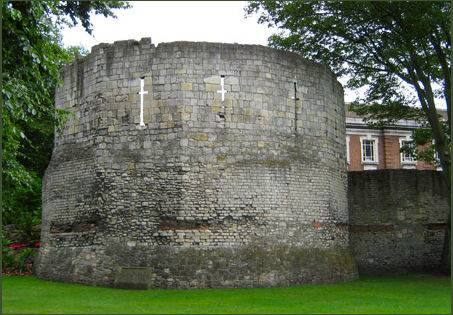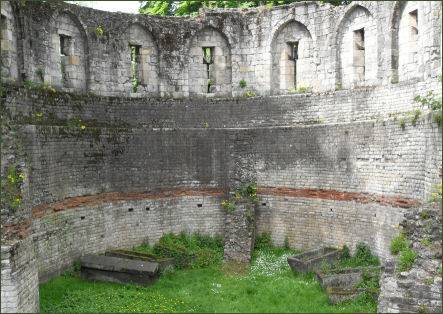Multiangular Tower
The Multangular Tower is situated in the attractive York Museum Gardens and is the most noticeable and intact structure remaining from the city's Roman walls. It is on the northern side of the gardens, between the Yorkshire Museum and St Leonard’s Hospital.


The tower was built as part of a series of eight similar defensive towers and stood at the west corner of the Roman legionary fortress of Eboracum. It was one of the two corner-towers of the huge stone wall that looked down onto the River Ouse. The walls are almost certainly the creation of Septimius Severus; however, the Multangular Tower is probably a later addition constructed during the reign of Emperor Constantine the Great around in 310–320 AD. It has ten sides, based on a regular fourteen-sided figure designed so that a circle through the internal angles of the internal face is tangential to the curve. The rear four sides are missing to provide access to the interior of the tower. A low plinth or skirt extends out from the lowest course.
In style, the tower protrudes from the fortress wall rather than standing behind it, was a development designed to enable defenders to fire down on anyone attacking the wall itself. The tower stands almost 30 feet (9.1 metres) tall, has an external diameter of 48.5 feet (14.8 metres) at the base and 46 feet (14 metres) above the skirt. The length of each side varies from 7.5 feet (2.3 metres) to 11 feet (3.4 metres) on the inner face. The tower projects beyond the curtain wall to a distance of 36.75 feet (11.20 metres). The foundations are concrete, atop which the tower extends having a rubble and mortar core between ashlar faced courses of small magnesian limestone blocks. At 15 feet (4.6 m) a scarcement reduces the thickness of the wall from 5 feet (1.5 m) to 3.25 feet (0.99 m), which continues for a further 4 feet (1.2 m) before being capped by 11 feet (3.4 m) of medieval masonry in which arrowslits, which date to the thirteenth century, are visible.
Five Roman stone coffins are housed in the tower, which were transported to the site from graveyards in York. Cannon ball damage, dating from the civil war can be seen in the wall to the North of the tower.
The medieval city walls of York are the most complete example of medieval city walls still standing in England today and extend for 2.5 miles, enclosing a total area of 263 acres. The walls include 4 main gates or 'bars', Bootham Bar, Monk Bar, Walmgate Bar and Micklegate Bar.
Guide to the Walls
| York City Walls | Bootham Bar | Fishergate Bar | Micklegate Bar & the Henry VII Experience |
| Monk Bar & the Richard III Experience |
The Multiangular Tower |
The Red Tower | Walmgate Bar |
Historic buildings in Yorkshire
